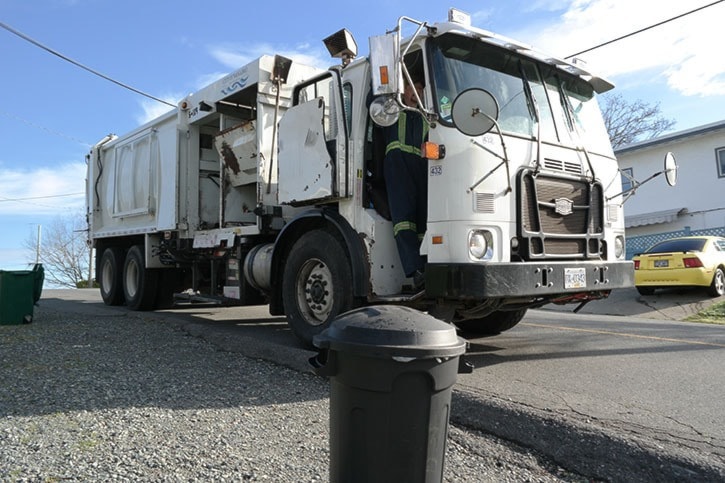Nanaimo’s first automated garbage trucks are in ‘park’ until next spring with no decision yet on how to deliver the new service.
The trucks were purchased for more than $880,000 under a plan to automate one-third of the Harbour City’s garbage collection this November, but council put the brakes on the plan five months before rollout to consider the results of a core services review.
The city now expects mechanical arms won’t reach for residents’ curbside bins until March or June of next year, and the issue of just how the city’s waste and recycling is collected still has to be decided by politicians, who will consider who should own new collection carts needed for automation – residents or the municipality – and if it should pull all services in-house or contract out recycling under a ‘hybrid’ model that would require less capital investment and cost users less, but decrease service levels to residents who would see kitchen waste picked up every second week.
Depending on what route city council takes, automation could happen in either a two-phased rollout next March, or all at once next June. The City of Nanaimo is opening the floor for residents to talk about core service review recommendations, including automated collection, during an e-town hall event Sept. 12.
Coun. Diane Brennan is not solidly in one camp or another, but is leaning toward an in-house model with city-owned carts.
“That was the original recommendation and I am leaning towards that because I think there’s cost savings in that area,” she said, adding she wants to hear from the public about what level of service it wants and whether it wants the cost of recycling to be less – something, in her view, it would be if it’s an in-house system.
 Coun. Ian Thorpe sees the pros and cons for hybrid and in-house, but what he’s not too keen on under a hybrid system is having kitchen waste picked up biweekly.
Coun. Ian Thorpe sees the pros and cons for hybrid and in-house, but what he’s not too keen on under a hybrid system is having kitchen waste picked up biweekly.
“I’ve heard from a lot of people that they don’t like the idea of food – kitchen waste – sitting for two weeks, especially in warm weather,” said Thorpe. “I know other places do it and apparently it works OK, but it’s just something that’s making me hesitate.”
Automated solid waste collection is already happening across B.C. in communities like Prince George, Kamloops, Kelowna, Williams Lake and Surrey.
City staff’s original pitch was for an in-house system, and aimed to address a system stretched with staff injuries and downtime with the fleet. City council agreed to move ahead with two automated trucks last year to automate collection for one-third of the city.
“I think automated collection is becoming the norm now, so I think we are absolutely working towards that just like many other communities are now,” said Charlotte Davis, the city’s manager of sanitation, recycling and public works administration.
The new trucks will mean employees can empty solid waste with the help of a joystick-operated mechanical arm, instead of heaving bins manually. Cameras give the refuse collector complete sight of the curbside and there’s an onboard computer system that links in with radio frequency chips attached to people’s carts so it knows what address the cart came from.
More cameras inside the hopper take a look at what comes out of peoples’ carts and can link issues with waste at a particular address. If the lid is ajar, for example, or a garbage can contained oil – which is prohibited – then that information is transferred in real-time to the city office to use in communication with residents, Davis said, adding it takes onus off the refuse collector to report every incident and removes the need to manually apply stickers. It also allows the city to keep records.
Davis said automation is a shift in service delivery, but with big benefits to residents. The wheeled carts are larger, more heavy-duty, keep smells out and are more user-friendly than bins without wheels, she said.
There will be new requirements for residents. Carts will have to be placed wheels against the curb, one meter away form one another and one metre away from any vehicles and shrubbery.
The city has already created a how-to video, brochures and information kits with a $25,000 budget to educate residents on what they would need to do for pickup.
City politicians are now at the stage of choosing to pull the service in-house or go with a hybrid system and deciding who pays for the carts.
With user-owned carts, the municipality would finance repayment of the carts to residents, and residents would be responsible to fix carts and replace them. The cost of city-owned carts are paid for through user fees but the city would take care of repairs and replacement.
